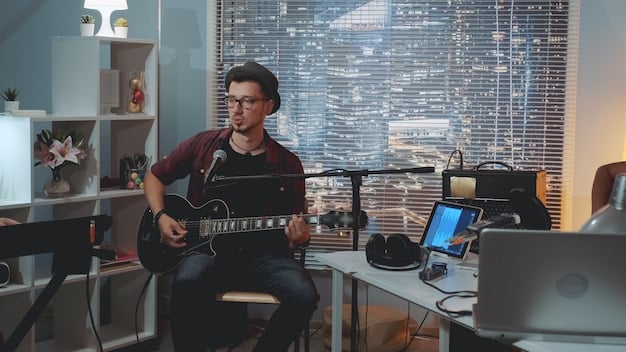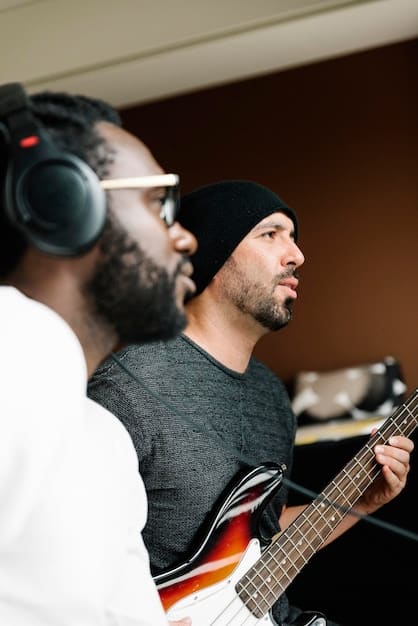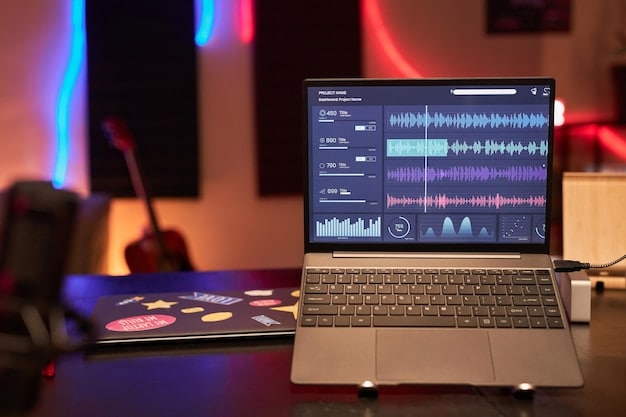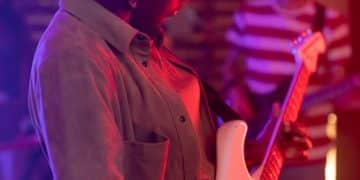DIY Music Promotion: Breaking Through Without a Major Label in 2025

Breaking through in the music industry without major label support is increasingly feasible for underground artists in 2025, largely due to advancements in digital tools and independent promotional strategies.
In an evolving music landscape, the question of whether DIY Music Promotion: Can Underground Artists Break Through Without Major Label Support in 2025? remains a pivotal one for aspiring musicians. The traditional gatekeepers of the industry have seen their influence wane as digital platforms empower artists directly. This shift presents both unprecedented opportunities and new challenges for those navigating the independent music scene.
The Evolving Digital Landscape: A New Frontier for Artists
The digital realm has fundamentally reshaped the music industry, offering underground artists an unprecedented array of tools and platforms to reach audiences without the traditional backing of major labels. This shift from a centralized, gatekeeper model to a decentralized, artist-centric ecosystem has profound implications for how music is created, distributed, and consumed.
Democratization of Production and Distribution
The barriers to entry in music production have dramatically lowered. Affordable, high-quality recording equipment and powerful digital audio workstations (DAWs) now allow artists to produce professional-sounding music from their home studios. This accessibility extends to distribution, with platforms like DistroKid, TuneCore, and CD Baby enabling artists to upload their music to major streaming services worldwide for a fraction of what traditional distributors would charge.
- Accessible Tools: High-quality DAWs (e.g., Logic Pro, Ableton Live) and affordable microphones.
- Global Reach: Digital distributors connecting artists to Spotify, Apple Music, and Amazon Music.
- Cost-Effectiveness: Reduced overheads bypass traditional studio and distribution fees.
The Power of Direct-to-Fan Engagement
Social media platforms, once supplemental marketing tools, are now central to an artist’s promotional strategy. TikTok, Instagram, YouTube, and even emerging platforms offer direct channels for artists to connect with fans, share their creative process, and build authentic communities. This direct engagement fosters loyalty and allows artists to bypass the need for traditional media gatekeepers. Moreover, these platforms provide valuable analytics, giving artists insight into their audience demographics and engagement patterns, allowing for more targeted and effective promotional efforts. The ability to interact directly with fans, answer questions, and build personal connections has created a more intimate and supportive environment for independent music to thrive. Artists can now leverage live streams, Q&A sessions, and behind-the-scenes content to maintain a constant dialogue with their audience.
This new ecosystem empowers artists to be their own record labels, marketing teams, and A&R representatives. While it demands a multifaceted skillset and a significant time investment, the potential for creative freedom and direct financial returns is immense. The traditional model, where a label might dictate creative direction or retain a large portion of earnings, is slowly being challenged by this independent, DIY approach. The autonomy gained allows artists to experiment more freely and build a brand that is truly reflective of their artistic vision. This control over their narrative and output is invaluable in today’s crowded market.
In summary, the digital landscape has transformed from a rigid, industry-controlled entity into a more flexible and accessible space for independent artists. The tools for creation, distribution, and promotion are now within reach of virtually anyone with a passion for music, leveling the playing field and empowering a new generation of DIY musicians.
Building a Strong Foundation: Branding and Online Presence
In the current music ecosystem, simply creating great music isn’t enough; artists must also cultivate a compelling brand and a robust online presence. This foundational work is crucial for standing out in a crowded market and attracting a dedicated fanbase. A cohesive brand identity helps artists communicate their unique vision and connect with listeners on a deeper level.
Crafting Your Artistic Identity
Your brand is more than just a logo or a band name; it encompasses your entire artistic identity. This includes your musical style, visual aesthetics, lyrical themes, and overall message. Developing a clear and consistent brand helps define who you are as an artist and what you represent. It should resonate with your target audience and be authentically you. Many successful independent artists carve out a niche by embracing a distinct persona or genre blend that sets them apart. This authenticity often builds a more loyal following than a manufactured image could.
- Visual Consistency: Album art, social media graphics, and merchandise should reflect your brand.
- Narrative Cohesion: Your lyrics, interviews, and public statements should align with your core message.
- Authenticity: Be genuine; your audience will connect with your true self.
Optimizing Your Digital Footprint
An optimized digital footprint is essential for discoverability. This involves creating and maintaining professional profiles across key platforms. Your website or EPK (Electronic Press Kit) should serve as your central hub, providing access to your music, bio, photos, videos, and contact information. Social media profiles must be active, visually appealing, and strategically utilized to engage with your audience. Furthermore, ensuring your music is available on all major streaming services is non-negotiable. Using high-quality images and video across all platforms is equally important, as visual content often drives initial engagement. Regularly updating your profiles with fresh content, such as new releases, tour dates, and behind-the-scenes glimpses, keeps your audience engaged and hungry for more. It also signals to algorithms that your content is current and relevant. Ultimately, a strong online presence acts as your digital storefront, inviting new listeners to discover your art and fostering a loyal community around your music.
The synergy between excellent branding and a well-managed online presence creates a powerful platform for independent artists. It allows them to control their narrative, present a professional image, and effectively communicate their artistic message to a global audience, all without the need for major label intervention. This self-sufficiency is a hallmark of the modern DIY musician.
Strategic Content Creation: Beyond the Music
In today’s oversaturated digital landscape, success for underground artists extends far beyond merely releasing music. Strategic content creation, encompassing a wide range of media beyond just songs, is vital for building a sustainable career. This multimedia approach helps capture and retain audience attention, fostering deeper connections.
Diversifying Your Content Portfolio
Artists should view themselves as content creators, not just musicians. This involves producing videos, behind-the-scenes footage, short-form clips for social media, live streams, and even podcasts. Each piece of content offers a unique way to engage with different segments of your audience and showcase different facets of your personality and creative process. For instance, a quick TikTok video demonstrating a new riff can be just as impactful as a professionally shot music video in terms of drawing new listeners. Regularly experimenting with various content formats helps keep your audience engaged and provides valuable data on what resonates most. The goal is to provide a comprehensive view of your artistry, not just the final product.
- Short-form Video: TikTok, Instagram Reels, YouTube Shorts for quick engagement.
- Long-form Video: Music videos, vlogs, documentary-style content for YouTube.
- Live Streams: Interactive sessions on Twitch, Instagram Live, or YouTube Live.
- Audio Content: Podcasts discussing your music, influences, or industry insights.
Leveraging Visuals and Storytelling
Visuals play a crucial role in music promotion. High-quality music videos, engaging album art, and professional photography are essential for making a strong first impression. However, it’s the storytelling aspect that truly captivates. Sharing your creative journey, the inspiration behind your songs, or personal anecdotes builds a stronger bond with your audience. This narrative can be woven into social media captions, blog posts, and spoken introductions during live performances. People connect with stories, and when they feel they understand the artist behind the music, their appreciation deepens. Authenticity in storytelling is key; manufactured narratives rarely resonate as strongly as genuine expressions of your experiences and artistic motivations. This personal touch transforms casual listeners into dedicated fans, a crucial step for achieving long-term success without a major label’s marketing budget.
By embracing a holistic approach to content creation, independent artists can build a rich, engaging world around their music. This strategic effort not only enhances discoverability but also cultivates a loyal community, proving that consistent, creative content can be as powerful as traditional marketing campaigns. The investment in diverse content pays dividends in increased reach and sustained fan interest.
The Power of Analytics and Data-Driven Decisions
In 2025, successful DIY music promotion is increasingly reliant on understanding and effectively utilizing data. Artists equipped with analytical insights can make informed, strategic decisions that optimize their reach and engagement, moving beyond guesswork.
Understanding Your Audience Through Data
Streaming services and social media platforms provide a wealth of data about your listeners. Analytics dashboards offer insights into demographics (age, gender, location), listening habits, engagement rates, and where your audience discovers your music. For instance, Spotify for Artists and YouTube Studio provide detailed reports that can reveal which tracks are performing best, which countries your listeners are in, and even the time of day your audience is most active. Regularly reviewing this data allows artists to tailor their content and promotional efforts to their core audience, leading to more effective campaigns. If your data shows a significant following in a particular city, for example, it might inform your touring decisions or localized marketing efforts.
- Demographic Insights: Target content and live performances to specific audience segments.
- Engagement Metrics: Identify what content resonates most and optimize future posts.
- Geographical Data: Inform tour planning and regional marketing strategies.
Optimizing Campaigns with Performance Metrics
Beyond understanding your audience, data helps evaluate the effectiveness of your promotional campaigns. Tracking metrics such as stream counts, video views, follower growth, website traffic, and merchandise sales provides a clear picture of what’s working and what’s not. If a particular social media campaign leads to a significant spike in streams, artists can replicate that strategy. Conversely, if an email marketing push yields low engagement, adjustments can be made for future campaigns. This iterative process of “test, measure, learn, and adapt” is crucial for maximizing the return on your time and effort. It allows for agile adjustments, ensuring resources are allocated efficiently. For example, A/B testing different ad creatives or post copy can provide compelling evidence on which variations perform better, leading to more effective ad spends.
The ability to make data-driven decisions transforms promotional efforts from speculative endeavors into evidence-based strategies. By embracing analytics, independent artists can work smarter, not just harder, refining their approach and significantly increasing their chances of breaking through without the costly infrastructure of a major label. This analytical mindset is a defining characteristic of successful DIY artists in the modern era.
Collaboration and Community Building: Strength in Numbers
While DIY music promotion emphasizes individual effort, the power of collaboration and community building remains an indispensable element for underground artists seeking to break through. Leveraging collective strength can amplify reach and foster a supportive environment. The solitary artist working in isolation often misses out on crucial opportunities for growth and exposure that come from networked interactions.
The Value of Artist-to-Artist Collaboration
Collaborating with other independent artists can be mutually beneficial. Joint projects, such as shared EPs, collaborative singles, or co-headlining tours, expose each artist to the other’s fanbase, effectively doubling their reach. Beyond audience expansion, collaborations can spark creative synergy, leading to fresh sounds and innovative ideas. Working with artists from different genres can broaden your musical horizons and introduce you to new production techniques or lyrical approaches. Forming genuine relationships with peers can also lead to invaluable mentorship, shared resources, and moral support, crucial for navigating the often-challenging independent music scene. This horizontal network often proves more enriching and sustainable than hierarchical industry connections.
- Cross-Promotion: Reach new audiences through your collaborators’ fanbases.
- Creative Growth: Learn from different artistic perspectives and production styles.
- Shared Resources: Pool efforts for recording, mixing, or touring costs.
Engaging with the Fan Community
Fostering a strong, engaged fan community is paramount. This goes beyond simple likes and comments; it involves creating a sense of belonging among your listeners. Initiatives like fan-exclusive content, Discord servers, private Facebook groups, or Patreon communities allow for deeper interaction and loyalty. Regularly responding to comments, running polls, asking for feedback, and even involving fans in creative decisions (e.g., choosing the next single artwork) makes them feel invested in your journey. True fans are often your most effective marketers, sharing your music with friends and advocating for your artistry. Treating fans as partners, not just consumers, transforms passive listeners into active participants in your success. This level of engagement builds a resilient support system, critical for the sustained growth of an independent artist.
The cultivation of strong relationships—both with fellow artists and with dedicated fans—is a cornerstone of successful DIY music promotion. It transforms individual endeavors into a collective movement, proving that even without major label backing, a robust network can provide the leverage needed for significant breakthroughs in 2025. This emphasis on community underscores a fundamental shift in how artistic success is achieved.
Monetization Strategies for Independent Artists
For underground artists operating without major label support, successful monetization is not just about earning income, but about building a sustainable career that funds their creative endeavors. Diversifying revenue streams is key to financial independence.
Beyond Streaming: Diversifying Income
While streaming royalties contribute to an artist’s income, they are often insufficient on their own. Independent artists must explore multiple avenues. Merchandise sales, for example, offer a direct way for fans to support artists financially while promoting their brand. Live performances, whether virtual or in-person, remain a significant source of income, fostering direct fan connection and creating memorable experiences. Licensing music for film, TV, advertising, or video games can provide substantial, non-dependent revenue. Furthermore, direct fan support platforms like Patreon allow artists to offer exclusive content or experiences in exchange for recurring pledges, creating a stable income base from their most dedicated followers. Exploring all these avenues ensures a robust financial foundation.
- Merchandise Sales: T-shirts, vinyl, digital downloads directly from artist stores.
- Live Performances: Gigs, tours, and virtual concerts.
- Music Licensing: Sync placements in media.
- Fan Subscriptions: Patreon, Bandcamp fan clubs, exclusive content platforms.
Strategic Use of Digital Platforms for Revenue
Each digital platform offers unique monetization opportunities. YouTube, for example, allows for ad revenue from videos, while Bandcamp is renowned for its artist-friendly revenue share model for digital and physical sales. TikTok’s Creator Fund and live stream gifting features provide additional avenues. Understanding the nuances of each platform and strategically leveraging them for maximum revenue is crucial. This might involve optimizing video content for YouTube ad views, promoting Bandcamp as the primary sales channel, or actively participating in TikTok trends to increase visibility and potential earnings. The key is to see each platform not just as a promotional tool, but also as a potential income generator, meticulously tracking which ones yield the best financial returns.
By adopting a multi-faceted approach to monetization, independent artists can build a resilient financial model that supports their artistic pursuits, proving that creative integrity and personal financial stability are not mutually exclusive in the DIY music scene of 2025. This independence from traditional label funding empowers artists to maintain creative control and build a truly sustainable career on their own terms.
Navigating Challenges and Sustaining Momentum
Even with the advantages of DIY music promotion, underground artists face significant challenges. Sustaining momentum requires resilience, adaptability, and a long-term strategic vision. The path to breakthrough is rarely linear and demands continuous effort.
Overcoming Saturation and Burnout
The ease of entry into the music industry means it’s an increasingly saturated market. Standing out requires consistent high-quality output and innovative promotional tactics. This constant demand can lead to artist burnout. To combat this, artists must prioritize self-care, establish clear boundaries between their creative and personal lives, and delegate tasks when possible (e.g., hiring a freelance publicist for a specific campaign). Setting realistic goals and celebrating small victories can help maintain motivation. It’s also vital to remind oneself of the passion that fuels the music, rather than getting lost in the relentless grind of promotion. Building a strong support system, including fellow artists and mentors, can also provide essential emotional and professional support.
- Time Management: Balance creative work with promotional tasks.
- Mental Health: Prioritize breaks and seek support to avoid burnout.
- Delegation: Outsource tasks to freelancers (e.g., graphic design, social media scheduling).
Long-Term Vision and Adaptability
The digital landscape is constantly evolving, with new platforms and trends emerging regularly. Independent artists must remain adaptable, willing to experiment with new technologies and marketing strategies. This involves continuous learning, staying updated on industry changes, and being open to pivoting when necessary. A long-term vision helps guide decisions, ensuring that current efforts contribute to overarching career goals, rather than just short-term gains. Building a sustainable career is a marathon, not a sprint, requiring patience, persistence, and a genuine passion for the craft. Regularly evaluating performance, seeking feedback, and iterating on strategies are crucial for sustained growth. Embracing challenges as opportunities for learning and growth can transform obstacles into stepping stones toward success.
Ultimately, breaking through as an underground artist without major label support in 2025 is not just about talent, but also about strategic execution, community engagement, diversified monetization, and an unwavering commitment to the journey. While challenging, the rewards of creative freedom and direct connection with a loyal fanbase make the DIY path incredibly fulfilling. The ability to endure setbacks and continuously innovate is what truly separates those who fade from those who ultimately thrive.
| Key Point | Brief Description |
|---|---|
| 🚀 Digital Empowerment | Affordable tools and platforms enable independent creation & global distribution. |
| 🎨 Strong Brand & Presence | Cohesive artistic identity & optimized online footprint are crucial for visibility. |
| 📈 Data-Driven Decisions | Analytics guide targeted promotion and optimize campaign effectiveness. |
| 🤝 Community & Collaboration | Artist collaborations and fan engagement amplify reach and support. |

Frequently Asked Questions
▼
Yes, absolutely. While challenging, the digital tools and platforms available in 2025 empower artists more than ever to build their brand, distribute music globally, and connect directly with fans. Success hinges on a strategic approach to content, strong online presence, and consistent engagement.
▼
Key platforms include Spotify, Apple Music, and others for distribution, YouTube for video content, and social media like TikTok and Instagram for direct fan engagement. Each platform serves a unique purpose in discovery, artist branding, and community building, requiring tailored content strategies.
▼
Extremely important. A cohesive brand and strong visual identity communicate who you are as an artist, helping you stand out in a crowded market. This includes consistent album art, social media aesthetics, and a clear narrative that resonates with your target audience, fostering deeper connection.
▼
Yes, through diversified income streams. Beyond streaming royalties, artists can earn from merchandise, live shows (both virtual and in-person), music licensing, and direct fan support platforms like Patreon. This multi-faceted approach creates a more stable and independent financial foundation.
▼
Challenges include market saturation and artist burnout. Overcoming these involves strategic content planning, prioritizing self-care, delegating tasks, and fostering strong community connections with fans and fellow artists. Adaptability to new trends and a long-term vision are also crucial for sustained momentum.

Conclusion
The landscape of the music industry in 2025 clearly indicates that underground artists possess an unprecedented capacity to break through without the traditional backing of major labels. The democratization of production, distribution, and promotion tools, coupled with the power of direct-to-fan engagement and data-driven strategies, has significantly leveled the playing field. While challenges such as market saturation and the risk of burnout persist, artists who intelligently leverage technology, cultivate strong personal brands, embrace collaboration, and diversify their revenue streams are well-positioned for sustained success. The future of music is increasingly independent, driven by authenticity and direct connection, empowering a new generation of artists to forge their own paths to prominence.





